Content
- 1 Growing plants and flowers on a hydrogel, the advantages of a hydrogel:
- 2 Features of the use of material in crop production
- 3 Advantages and Disadvantages of Using a Hydrogel
- 4 The main ways to use the hydrogel
- 5 Features of growing in a hydrogel
- 6 How to plant a plant in soil with a hydrogel - step by step instructions
- 7 How to germinate greens with a hydrogel
- 8 Product Description
- 9 What are gel beads for?
- 10 Variety of hydro balls
- 11 Method of using the hydrogel
- 12 Hydrogel and gardening
- 13 Hydrogel for gardeners
- 14 Positive and negative qualities
Modern technologies do not stand still, not only in relation to gadgets, but even in crop production. One of these ultra-fashionable novelties is the cultivation of plants and flowers on a hydrogel.
This substrate began to be used in agriculture, and only a few years later the advantages of planting indoor plants in it were discovered.
A hydrogel (or aqua soil) is a jelly-like mass of small grains. This polymer does an excellent job of retaining moisture, absorbing and transferring it to plants. By itself, it does not have a definite shape, which helps to fill a vessel or flowerpot with it, even the most bizarre shape.
Aqua primer does not have an attractive color (when dry it is white), but it is easily painted in bright colors. You can give it an attractive look both with natural food colors, and juice of vegetables or berries (for example, blueberry or beetroot).
Growing plants and flowers on a hydrogel, the advantages of a hydrogel:
- It easily holds a large amount of water - only 10 grams of a substance can absorb up to 2 liters of liquid. This advantage is especially noticeable in the absence of the possibility of timely watering.
- It is an environmentally friendly and safe substance.
- Hydrogel can be used as an additional medium for growing plants in soil, as well as a substitute for soil for decorative indoor flowers.
- Vases with hydrogel, unlike conventional ground fillers, serve as an original addition and decoration of interior design
- Can be used as a transport material when transporting plants over long distances.
As with everything, aqua soil has disadvantages:
- Not all plants can be grown in a hydrogel without adding soil; Most pets are not comfortable in it, since in addition to water, they require feeding and fertilization.
- The material is not durable and loses its properties
- Do not expose the hydrogel to direct sunlight.
Aqua soil is used for:
- decorative growing of flowers at home
- for adding to the soil when planting plants outdoors
- for germinating seeds
- as interior decoration
Using a hydrogel as a primer additive
This method will work for many plants as they will benefit from both aqua soil and soil.
For planting, use a mixture in the ratio of 1 liter of soil to 1 gram of gel.
The hydrogel granules are poured with clean water and left to infuse. After contact of the substrate with the liquid, it swells and increases in volume several times. After a few hours, the excess water must be drained, and the hydrogel must be mixed with the prepared soil. It is ready for planting a plant in it.
Such soil perfectly retains water and nutrients, nourishing the roots of the plant.It is used for planting ferns, ivy, ficus, dieffenbachia and others.
Use of pure aqua soil
The substrate will serve as an additional decoration for the interior, but, unfortunately, not all plants are suitable. The main condition for the use of a hydrogel is the absence of a drainage hole in the container with it. And not all flowers can develop in such an environment. In addition, it does not tolerate direct sunlight, which means that the plants living in it should also prefer shade.
It is best to use a pure hydrogel for moisture-loving greens with no special nutritional requirements.
Aqua soil is a novelty of modern gardening and plant growing. It is widely used outdoors, adding ornamental plants to the soil, and also as an independent material. Due to the possibility of giving it colorful shades, hydrogel is actively used as a decoration for compositions of flowers and original gifts.
The hydrogel is characterized by the fact that it can absorb moisture and retain it for a long time, due to which it is often used in indoor floriculture and when growing seedlings. Previously, this polymer compound was widely used in the agricultural industry, but now phytodesigners and flower growers have turned to it. Tellingly, plants can be grown both directly in the hydrogel and in soil mixed with this substance. The moisture that is absorbed by the hydrogel does not flow out onto the tray and does not evaporate; moreover, it does not lose its original beneficial properties. So, today you will learn everything about hydrogel for plants - application, features, pros and cons. The article will also provide step-by-step instructions for using the polymer compound.
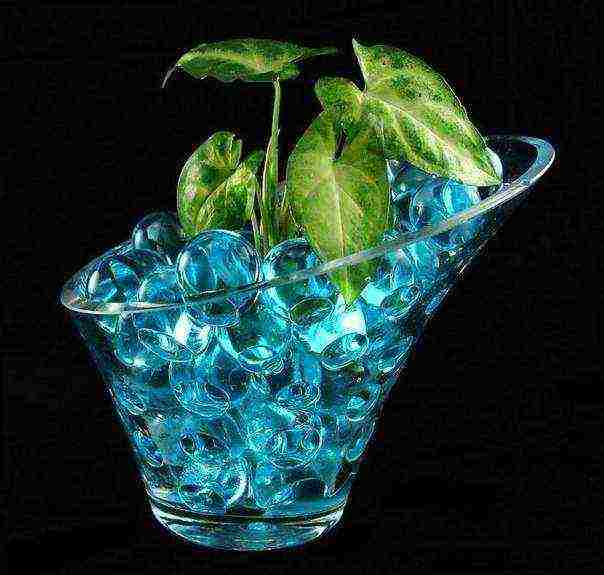
Plant hydrogel - application
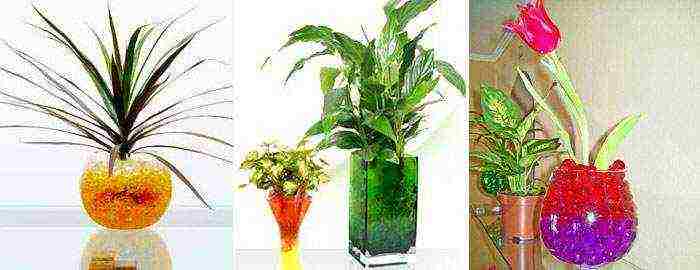
Using a hydrogel
Features of the use of material in crop production
A hydrogel is a polymer that makes great seedlings grow. Tellingly, when plants develop, they receive all the nutrients they need. First of all, the hydrogel is widely used to obtain seedlings.

Hydrogel Balls
To get high-quality seedlings, the gardener has to face a number of difficulties. So that the seedlings turn out to be healthy and strong, you need not only good lighting and a well-prepared soil mixture, but also competent watering. Moisture is very useful for young seedlings, but in excess it can lead to decay of the roots, which, in turn, will cause the subsequent death of plants. To avoid all these troubles, you can use a hydrogel, which has unique properties - it absorbs moisture and retains it for the full growth of the grown crops.

Miracle crystals or hydrogel
Note! The hydrogel is used as a planting substrate (a kind of container with water) or as a special additive that retains moisture for the prepared soil mixture.
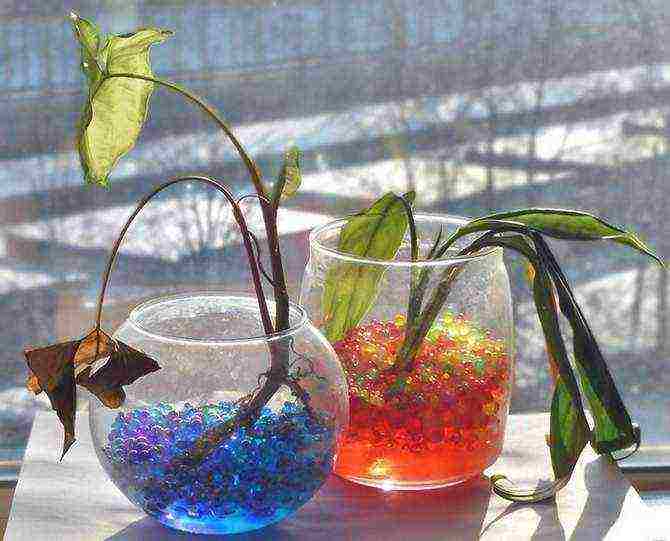
How is the hydrogel used?
The novelty, which appeared on the domestic market relatively recently, has already managed to acquire numerous admirers. If you start using it to grow indoor flowers or seedlings, you will no longer worry about watering and feeding young seedlings. This is explained by the fact that polymer granules absorb not only water, but also fertilizers in liquid form, due to which food is supplied as needed. It turns out that hydrogel is the ideal material for minimizing plant care, as well as reducing stress during traumatic soil transplantation.
The material is sold in the form of small beads like beads. If you add water to these balls, they swell, after which the polymer is ready for further use.
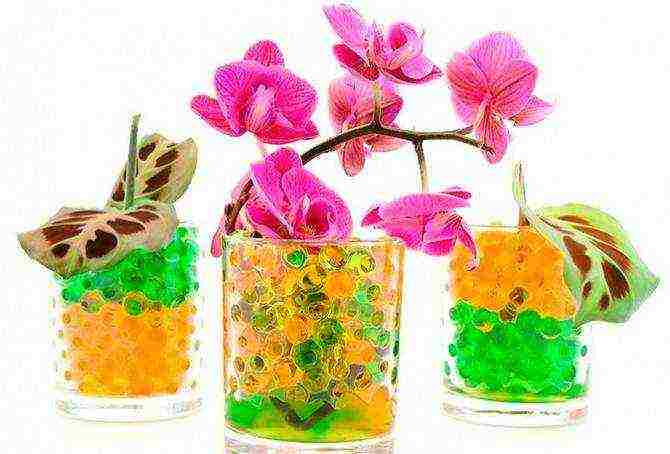
Indoor plant hydrogel
Advantages and Disadvantages of Using a Hydrogel
Despite the effectiveness and certain popularity, the described polymer granules have not yet found mass distribution. First of all, this is due to their recent appearance on the domestic market and the fact that most of the buyers do not know about the advantages of the material. And so that you don't have any doubts, let's get acquainted with the pros and cons of using a hydrogel.

Plant hydrogel
As for the benefits, these include:
- increased moisture absorption (granules absorb 300 times their own weight), which allows maintaining the substrate moisture level required for plants for a long time;
- economy (to get 1 liter of base, only 1-1.6 g of dry granules are enough);
- earlier seed growth when compared with traditional cultivation;
- preservation of all trace elements present in the substrate (they are not washed out);
- high-quality aeration of seeds and roots.
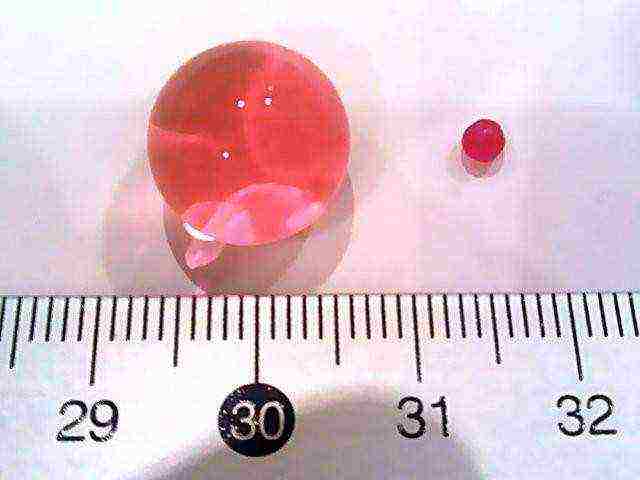
Dry and swollen granules of material

The hydrogel has absorbed water
However, there are disadvantages that you also need to know about before buying a hydrogel.
- You cannot grow crops in a hydrogel that have leathery seeds (such as sweet peas). In addition, when adding seed to a hydrogel, you must take into account the individual characteristics of a particular crop.
- It is also necessary to maintain the required temperature of the surface where the plants with the hydrogel are located - this will prevent hypothermia of the seedlings.
- Finally, the granules should not be reused, even if the manufacturers claim otherwise. The fact is that the already used hydrogel loses its absorbing properties, in addition, it becomes dark and wrinkles. Finally, bacteria can easily develop on the pellets after exposure to air. Therefore, the only thing this material will do is to use it in the form of a moisture-retaining additive for a soil mixture.

Indoor flowers in hydrogel
Note! Thanks to all the advantages and disadvantages of the material listed above, you can objectively assess your own capabilities and the likelihood of obtaining healthy plants.
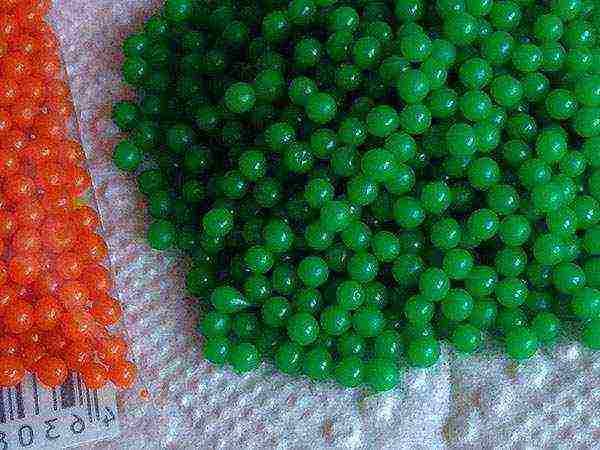
Hydrogel
The main ways to use the hydrogel
There are several ways to use polymer granules at once, let's take a closer look at each of them.
Table. Methods of using the hydrogel.
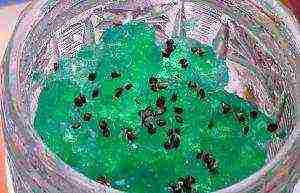 Method # 1 |
The seeds are placed in pre-prepared material. First, the granules are soaked, then crushed with a blender or grind through a sieve - as a result, a homogeneous mixture should be obtained. A layer of hydrogel with a thickness of 3 cm is placed in the pot, and on top of it, pressing a little, the seeds are placed. Excessive deepening of the seed is undesirable, because it can remain without oxygen, and this will negatively affect the quality of seedlings. After planting, the pots are covered with foil to ensure the desired microclimate. The cover can be removed daily to ventilate crops and remove condensation. |
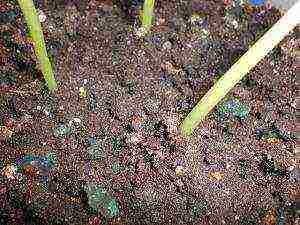 Method number 2 |
The hydrogel is also used as a moisture-absorbing additive in the soil mixture, which also gives excellent results. Here dry granules are mixed with the substrate (1: 3 or 1: 4), and the resulting mass is poured into a container. |
 Method number 3 |
The last option is to use a hydrogel when planting in open soil. The roots are dipped into the swollen mass, and the seedlings are placed in the holes. Thanks to this, stress is reduced, and the plants are provided with moisture for the first time. |
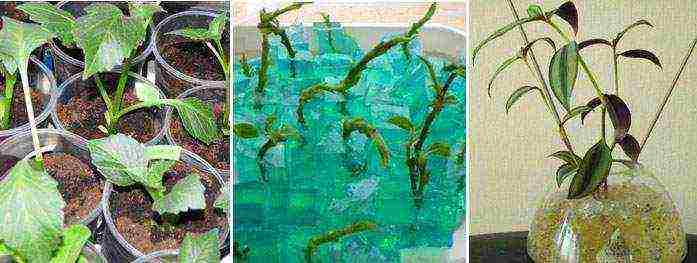
In a mixture of hydrogel and earth, it is very convenient to grow plant cuttings, germinate seeds. Prepare such a mixture in the same way as a mixture for indoor plants.
Note! Hydrogel is an environmentally friendly material that stimulates the growth of crops and has a positive effect on the quality of the soil.
Video - How to germinate seeds with hydrogel
Features of growing in a hydrogel
Today, the hydrogel is sold in different colors, so the plant in it may well turn into a decoration, a beautiful and original composition. The material is not very expensive, and if we consider that its consumption is insignificant, then we can assume that the bag will last for a fairly long time.
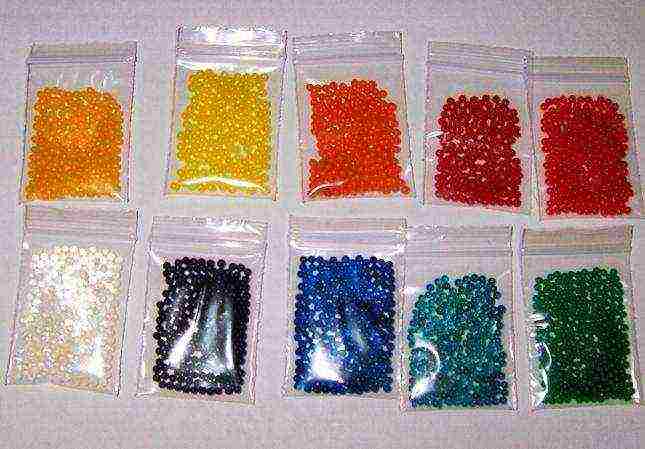
Hydrogel granules
Capacities... They must be transparent so that the granules of the material are clearly visible. The shape of the dishes does not matter at all, because when planting plants, the risk of damage to the roots is minimal. If the culture is small and grows with rosettes, then you can take a glass goblet for it, and if the plant is larger, then a vase will do.
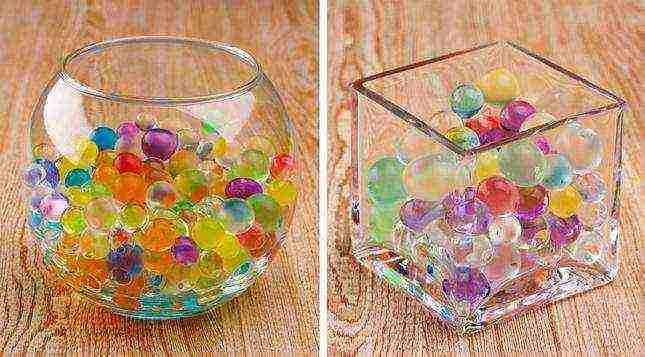
Glass containers with hydrogel
How to prepare a hydrogel... It is filled with purified distilled / settled water (about 300 ml per 1 g of material). More precise proportions should be indicated by the manufacturer on the packaging.
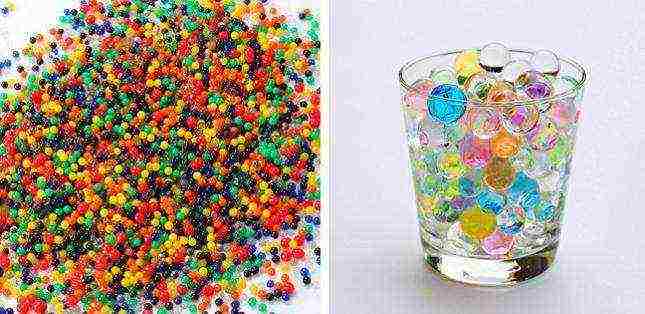
Hydrogel
Note! Do not grow plants in this way that need frequent watering. For example, epiphytes and succulents for the most part store moisture in the root system and leaves, and therefore staying in a humid environment can cause decay.
Landing features... The procedure is not much different from planting in ordinary soil. The container is filled with swollen granules, then a plant with pre-washed roots is placed there. If seeds are planted for seedlings, then the hydrogel after swelling must be crushed, as mentioned earlier. In a word, everything is quite simple. It is only necessary that the plants be in a strictly vertical position (and this can be difficult, since the material is very slippery).

Plant in hydrogel
How to care... Watering should be done six times less often than with traditional cultivation. The fact that plants need to be watered can be understood by a slightly settled hydrogel (evidence of a large amount of moisture leaving).
How to plant a plant in soil with a hydrogel - step by step instructions
If you plant an indoor flower in such soil, then it will greatly facilitate the care of it. Moreover, the substance will help the flower quickly get used to new conditions.
Step one... First, mix the hydrogel with the prepared potting soil. Approximate proportions are 2-3 grams of substance per 1 liter of soil.
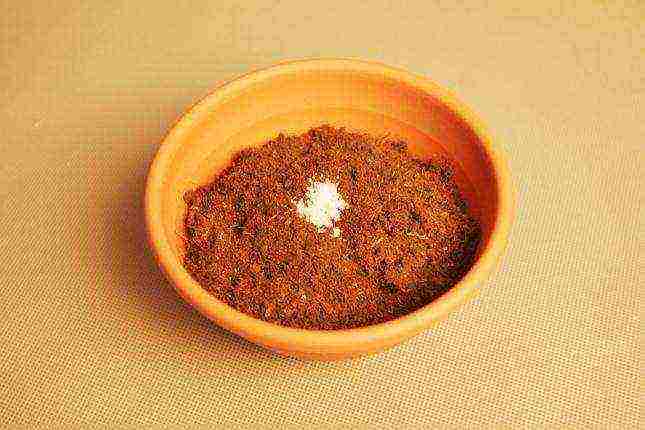
Hydrogel is added to the soil
Step two... After that, thoroughly mix the granules with the soil.
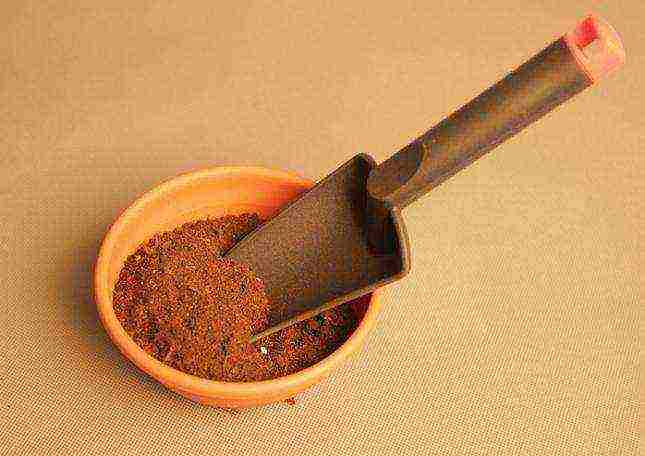
The granules are mixed with the ground
Step three... Pour the resulting mixture well so that it is saturated and the substance absorbed enough liquid. After that, you can proceed directly to planting plants.

Watering the mixture
Note! Polymer granules do not lose their original qualities for 3-6 years, which means that they can be applied only once directly during planting.
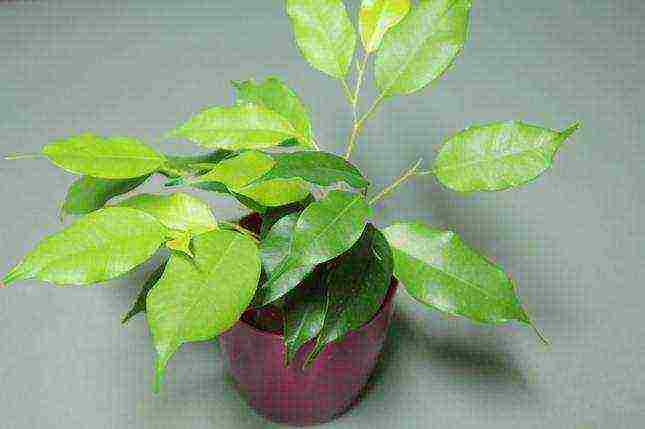
Plant grown in hydrogel
What cultures are suitable for this?
If we talk about a mixture of substrate and hydrogel, then moisture-loving crops are more suitable for this, as well as those plants that are suitable for hydroponic cultivation. Among indoor plants in soil with polymer, chlorophytum, euphorbia, ivy, bastard, Kalanchoe and others feel great. And beautiful petunias or saintpaulias after planting in such a substrate will develop faster and bloom better.
As for the care of crops planted in soil with hydrogel, it is almost the same as in conventional cultivation. The only exception is watering - in this case, it should not be too frequent.
How to germinate greens with a hydrogel
According to doctors, the daily use of greens helps to maintain health and youth for many years. And it is quite obvious that freshly picked greens are the most useful. In the summer it is grown in the beds, but in the winter you can arrange a small "vegetable garden" on the windowsill.
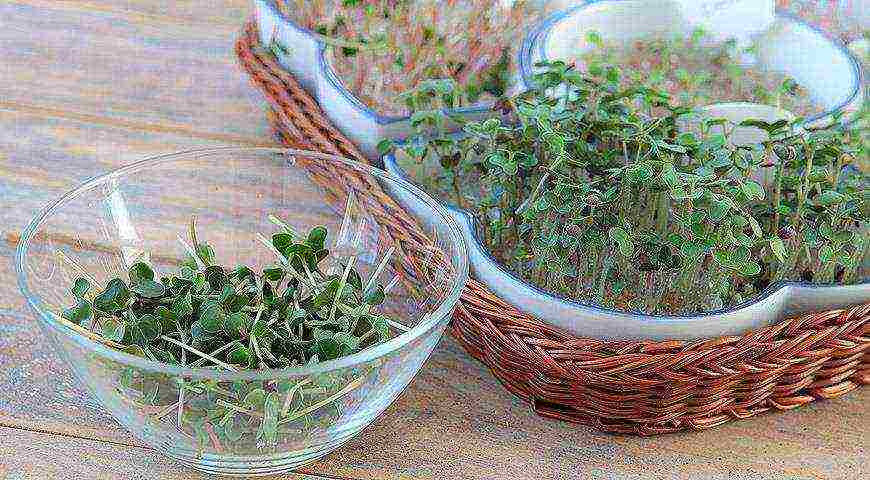
Germinating greens in a hydrogel
Before getting started, prepare:
- seed material;
- hydrogel;
- sowing containers.
After preparing everything necessary, proceed in accordance with the instructions. For the convenience of site visitors, it is shown in the form of a table.
Table. Do-it-yourself greens in a hydrogel.
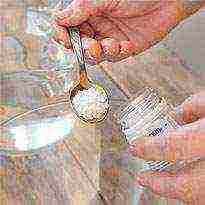 Step one |
To get started, take the hydrogel balls, put them in a large bowl, fill them with water and keep them at room temperature for 8 hours. |
 Step two |
When the material has swollen, place it in the planting containers. Remove excess liquid (if any) by discarding the balls in a colander. |
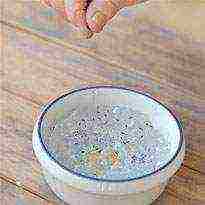 Step three |
Spread the seeds over the surface of the hydrogel, but do not cover. Do not wet them in advance - the granules will provide the seed with the amount of moisture necessary for germination. |
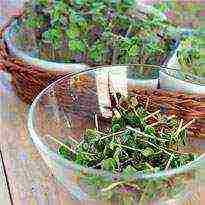 Step four |
When the seedlings reach about 4-5 centimeters in size, you can start harvesting. And the containers that have become empty can be used for a new sowing. |
How to water aloe at home
If experienced growers know well what conditions are needed for aloe, then a beginner may find the growing technology and ensuring proper care for it rather complicated. For example, it can be helpful to learn how to water aloe at home.
Video - Tips for growing in a hydrogel
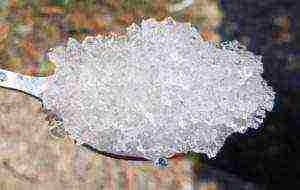 Hydrogel for plants are beautiful and bright balls that are used to grow indoor flowers. They are especially useful if the owners of the plants leave their homes for a long time. Such a device in floriculture appeared quite recently, but quickly gained popularity among gardeners. What is this aqua primer, what is it for and how to use it?
Hydrogel for plants are beautiful and bright balls that are used to grow indoor flowers. They are especially useful if the owners of the plants leave their homes for a long time. Such a device in floriculture appeared quite recently, but quickly gained popularity among gardeners. What is this aqua primer, what is it for and how to use it?
Product Description
Few know what a hydrogel is, despite the fact that it is gaining more and more popularity. Gel beads are a common polymer that has been crushed into powders or granules of various shapes.
A feature of hydroballs is their ability to absorb significant volumes of liquid, which later simply evaporates or is absorbed by the rhizome of the plant. Thanks to this ability, even the smallest balls can swell to very large sizes.
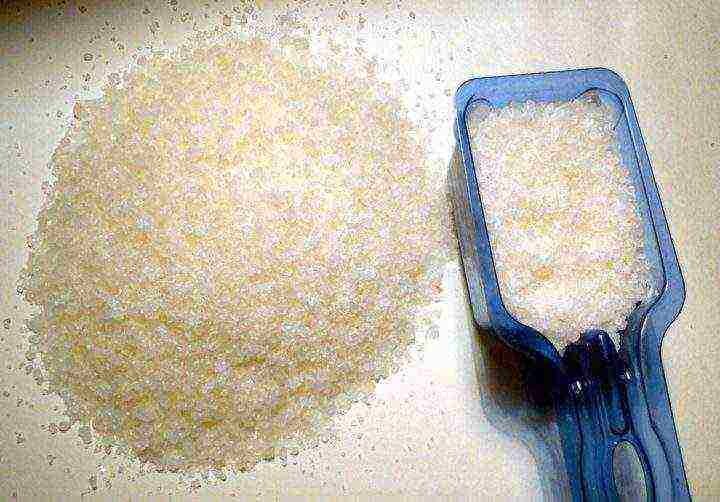
Hydrogel in crystals
1 g of hydrogel granules can absorb about 200 ml of water. Therefore, to remove about 3 liters of liquid, you will need only 2 tbsp. l. balls.
A hydrogel is a sterile substance. In it, pathogenic microflora is incapable of starting. The material gives off moisture gradually and slowly, so you don't have to worry about the possible rotting of the plant rhizomes.
The balls do not contain any useful ingredients.
What are gel beads for?
A hydrogel for plants will be useful in several cases:
- A very effective way to germinate seeds and root cuttings.
- In this way, nutrients can be easily and sustainedly delivered to the plants.
- Hydroballs retain a significant supply of water, so that plants can remain without moisture for a long time.
- The gel acts as a decorative element in decorating flowerpots. They fill a container with indoor plants or with freshly cut flowers.
It is important to know that aqua soil for flowers can absorb not only moisture, but also all the nutritional components it contains. They will be accessible to the roots of the plant. Therefore, the flowers can be fed freely by mixing the balls with the soil.
Variety of hydro balls
The gel beads are available in the two most common forms - soft and firm. They differ both in structure, and in the purpose of application, and in cost.
Soft gel beads are the most common type. It is introduced into soil mixtures for indoor flowers, for germinating seeds, for planting horticultural and horticultural crops. Due to the elastic and soft structure and small size, the roots of the plant can freely and freely penetrate directly into the balls and through them and absorb moisture and nutrients.
Such a hydrogel is always made colorless and, in rare cases, is operated independently. Most often, hydroballs are mixed with a substrate, this helps to prevent soil acidification from introducing a large amount of liquid and contributes to its speedy and uniform drying.
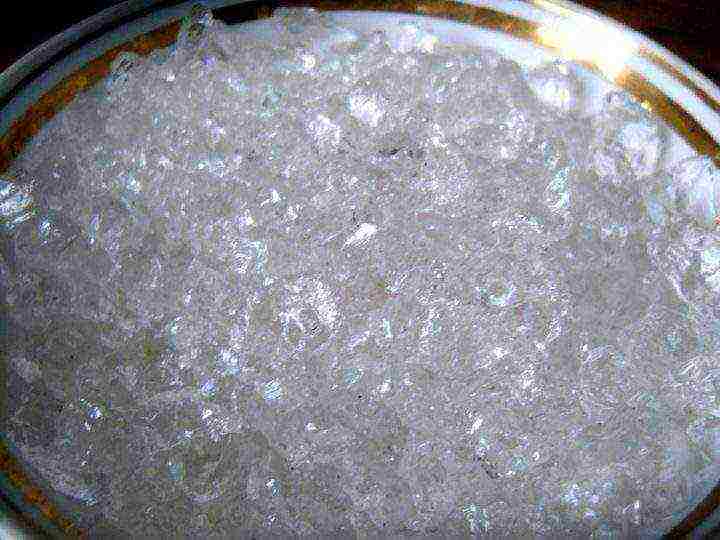
Hydrogel
Dense gel balls (or aqua soil) are much more expensive than soft ones. The material can be of different shapes and sizes. The high price does not allow the use of such material in horticulture and horticulture. The aqua primer differs from the usual gel and in that it can include rhinestones, sparkles, and is often painted in different colors. Such a colored hydrogel is used for transparent flower pots, in addition, it can be used to create charming florariums.
Another use for hard gel beads is air freshening. To improve the smell in the room, dry gel balls are poured with water with essential oils or other scented liquids. When the aqua soil is saturated with moisture, the balls are laid out in glass containers and placed around the room. A pleasant aroma will spread throughout the apartment for a long time.
Such soil is very convenient: even if a family member or a pet overturned a container with balls, they can be very easily collected even without using a vacuum cleaner.
It is important to remember that when filling with colored balls, you need to decompose each shade in different containers and let them swell in water. Only then can they be mixed.
Method of using the hydrogel
Florists use the remedy for plants in different ways. How to use the hydrogel is described in detail in the instructions for use. There are almost no restrictions on the choice of plants; some types of flowers can be grown directly in the substance. Be sure to remember about mineral fertilizers. It is allowed to mix the balls with the soil, in this case the gel is useful for retaining moisture, while for 1 liter of substrate it is enough to add about 2 g of dry hydro balls. Such manipulations are best done during transplantation.
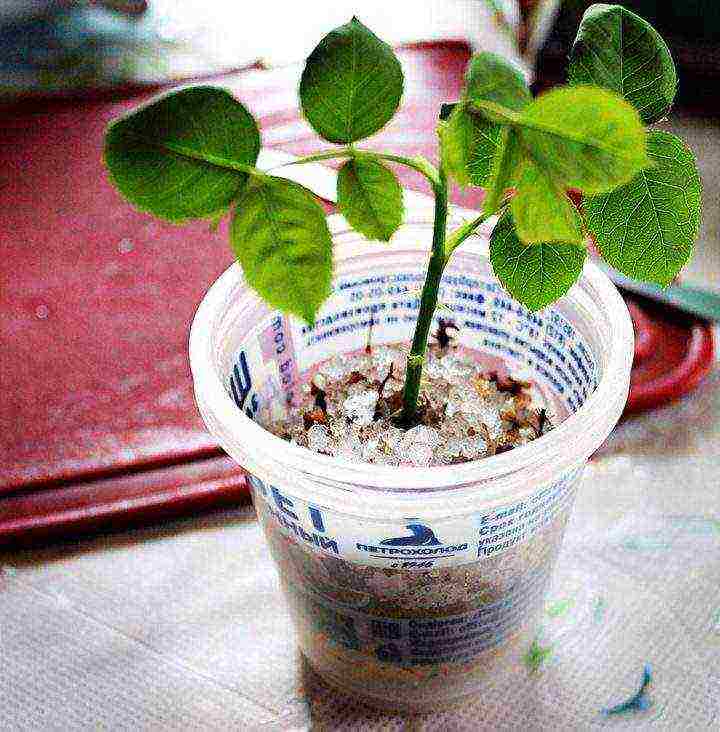
Growing in a hydrogel
If you grow flowers only in a pure hydrogel, then several factors should be taken into account:
- Watering should be done with good water, settled, filtered. Liquid directly from the tap can leave an unpleasant coating on the balls or the gel can turn green.
- When a flower has a too voluminous root system, then it can greatly creep over the flowerpot and cover all the balls. This will make the pot look unattractive.
- Some types of plants when grown in a hydrogel can "suffocate" from a lack of oxygen, so they need to be transplanted.
Interestingly, unused gel balls must be stored in the refrigerator, and only in an airtight container. Otherwise, the gel begins to crystallize and the material loses its capacity.
Hydrogel and gardening
How can a hydrogel help in gardening? It is very useful to use it for the development and rooting of petioles or for propagation of bushes by layering. You can mix it with soil at a rate of 1: 5 for transferring seedlings to open ground, which is not always suitable for everyone. A hydrogel can help make the soil more fertilized, especially if the plant needs nutrients. Also, gel balls are used to loosen heavy soils, this facilitates the penetration of more oxygen.
Water balls are very useful in spring when snow melts. They are placed dry in the ground. Then the same balls can be dug into the soil around the young seedlings.
Hydroballs are added even to the near-stem areas of the soil of already mature fruit-bearing trees.
Hydrogel for gardeners
Very often this gel is also used by gardeners. Therefore, it is worth figuring out how to use it correctly.This material is an ideal medium for germinating seeds without a hard shell, as well as for seedlings until they are transferred to open ground. In addition, a small part of the balls can be dug into the soil along with the seedlings, where it will feed young plants for a long time.
Tomato seedlings can be kept in this "soil" until it blooms. It is important not to forget about periodic feeding. This will help increase yields, prevent diseases that young individuals become infected in open soil.
If you use a hydrogel for plants in the open field, then do not forget and skip watering. This can affect crop yields and plant health. Therefore, it is better to flood the plants grown in soil with hydrogel with water than to leave them without moisture.
With the help of a hydrogel, only such vegetables are grown: tomatoes, potatoes, radishes, cabbage, cucumbers. But for eggplants, this method is not suitable, it gives poor results.
The beads of gel are instilled into a depth of 5 cm. For light soil, 10-20 g of hydrogel per 1 m² will be sufficient. If the soil is heavy, clayey, then you will need from 20 to 30 g of gel balls per 1 m²
Positive and negative qualities
This method of growing plants has definitely more positive qualities. Using a hydrogel, it is possible to provide the plant with a constant metered access of liquid. The gel does not allow the rootstock of the plant to rot, decorates the interiors with its unusual design.
But with its usefulness, one should not forget that plants need nutrients, which are important to periodically introduce. Watering also decreases, but does not decrease.
Hydroballs can bloom under the influence of direct rays of the sun. And this is a big minus. You cannot use the same gel for growing different plant specimens. From this, the gel ceases to be sterile.
Many people are concerned about the safety of this material. Hydrogel is an absolutely safe product, since it does not evaporate any toxic substances, and upon decomposition it forms water, carbon dioxide and ammonium. This explains its harmlessness.
It is recommended to adhere to all tips, rules and features. Hydrogel for plants is a very convenient and effective tool for gardeners.


